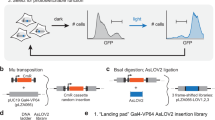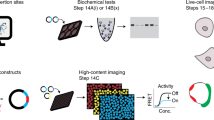Abstract
Proteins frequently display modular architecture with several domains and segments connected by linkers. Proper protein functionality hinges on finely orchestrated interactions among these constituent elements. The underlying modularity lends itself to the engineering of hybrid proteins via modular rewiring; novel properties can thus be obtained, provided the linkers connecting the individual elements are conducive to productive interactions. As a corollary, the process of protein engineering often encompasses the generation and screening of multiple linker variants. To aid these steps, we devised the PATCHY method (primer-aided truncation for the creation of hybrid proteins) to readily generate hybrid gene libraries of predefined composition. We applied PATCHY to the mechanistic characterization of hybrid receptors that possess blue-light-regulated histidine kinase activity. Comprehensive sampling of linker composition revealed that catalytic activity and response to light are primarily functions of linker length. Variants with linkers of 7n residues mostly have light-repressed activity but those with 7n + 1 residues mostly have inverted, light-induced activity. We further probed linker length in the context of single residue exchanges that also lead to an inversion of the signal response. As in the original context, activity is only observed for certain periodic linker lengths. Taken together, these results provide mechanistic insight into signaling strategies employed by sensory photoreceptors and sensor histidine kinases. PATCHY represents an adequate and facile method to efficiently generate and probe hybrid gene libraries and to thereby identify key determinants for proper function.
Access this chapter
Tax calculation will be finalised at checkout
Purchases are for personal use only
Similar content being viewed by others
References
Pawson T, Nash P (2003) Assembly of cell regulatory systems through protein interaction domains. Science 300:445–452
Gokhale RS, Khosla C (2000) Role of linkers in communication between protein modules. Curr Opin Chem Biol 4:22–27
Amet N, Lee H-F, Shen W-C (2009) Insertion of the designed helical linker led to increased expression of Tf-based fusion proteins. Pharm Res 26:523–528
Möglich A, Yang X, Ayers RA, Moffat K (2010) Structure and function of plant photoreceptors. Annu Rev Plant Biol 61:21–47
Ziegler T, Möglich A (2015) Photoreceptor engineering. Front Mol Biosci 2:30
Ryu M-H, Gomelsky M (2014) Near-infrared light responsive synthetic c-di-GMP module for optogenetic applications. ACS Synth Biol 3:802–810
Wu YI, Frey D, Lungu OI, Jaehrig A, Schlichting I, Kuhlman B, Hahn KM (2009) A genetically encoded photoactivatable Rac controls the motility of living cells. Nature 461:104–108
Möglich A, Ayers RA, Moffat K (2009) Design and signaling mechanism of light-regulated histidine kinases. J Mol Biol 385:1433–1444
Diensthuber RP, Bommer M, Gleichmann T, Möglich A (2013) Full-length structure of a sensor histidine kinase pinpoints coaxial coiled coils as signal transducers and modulators. Structure 21:1127–1136
Ohlendorf R, Schumacher CH, Richter F, Möglich A (2016) Library-aided probing of linker determinants in hybrid photoreceptors. ACS Synth Biol 5(10):1117–26. doi:10.1021/acssynbio.6b00028.
Ostermeier M, Shim JH, Benkovic SJ (1999) A combinatorial approach to hybrid enzymes independent of DNA homology. Nat Biotechnol 17:1205–1209
Ostermeier M, Nixon AE, Shim JH, Benkovic SJ (1999) Combinatorial protein engineering by incremental truncation. Proc Natl Acad Sci 96:3562–3567
Lutz S, Ostermeier M (2003). Preparation of SCRATCHY hybrid protein libraries. Directed Evolution Library Creation: Methods and Protocols 143–151
Arnold FH, Georgiou G (2003) Methods in molecular biology, vol. 231. Directed evolution library creation methods and protocols. Humana Press, Totowa, NJ
Ostermeier M (2003) Theoretical distribution of truncation lengths in incremental truncation libraries. Biotechnol Bioeng 82:564–577
Ohlendorf R, Vidavski RR, Eldar A, Moffat K, Möglich A (2012) From dusk till dawn: one-plasmid systems for light-regulated gene expression. J Mol Biol 416:534–542
Gleichmann T, Diensthuber RP, Möglich A (2013) Charting the signal trajectory in a light-oxygen-voltage photoreceptor by random mutagenesis and covariance analysis. J Biol Chem 288:29345–29355
Lupas AN, Gruber M (2005) The structure of alpha-helical coiled coils. Adv Protein Chem 70:37–78
Engelhard C, Diensthuber RP, Möglich A, Bittl R (2016) Blue-light reception through quaternary transitions. Submitted
Berntsson O, Diensthuber RP, Panman MR, et al (2016) Conformational photoactivation of a light-oxygen-voltage photosensor. Submitted
Leung DW, Chen E, Goeddel DV (1989) A method for random mutagenesis of a defined DNA segment using a modified polymerase chain reaction. Technique 1:11–15
Acknowledgments
Discussions with C. Engelhard and R. Bittl (Freie Universität Berlin) are appreciated. Financial support through Deutsche Forschungsgemeinschaft grant MO2192/4-1 (A.M.), through a Sofja-Kovalevskaya Award by the Alexander-von-Humboldt Foundation (A.M.), and through Boehringer-Ingelheim Fonds (R.O.) is gratefully acknowledged.
Author information
Authors and Affiliations
Corresponding author
Editor information
Editors and Affiliations
Rights and permissions
Copyright information
© 2017 Springer Science+Business Media LLC
About this protocol
Cite this protocol
Stabel, R., Stüven, B., Ohlendorf, R., Möglich, A. (2017). Primer-Aided Truncation for the Creation of Hybrid Proteins. In: Stein, V. (eds) Synthetic Protein Switches. Methods in Molecular Biology, vol 1596. Humana Press, New York, NY. https://doi.org/10.1007/978-1-4939-6940-1_18
Download citation
DOI: https://doi.org/10.1007/978-1-4939-6940-1_18
Published:
Publisher Name: Humana Press, New York, NY
Print ISBN: 978-1-4939-6938-8
Online ISBN: 978-1-4939-6940-1
eBook Packages: Springer Protocols




